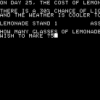Taking a different approach to the question, perhaps a contributing factor to the perceived problem you are trying to solve, OP, is that the differences between weapons are too subtle. In most action games, weapon choices (and others) tend to be distinctive and stratified -- that is, the differences between weapons are more pronounced, and their strategic implications are clear as a result. In games with more of a simulation bent -- thing of a racing simulation or a game like armored core -- the details *are* nuanced and important, but those choices are made separate from the main action. Generally, these kinds of genre tropes evolve because they suit clusters of players with similar preferences (as here, between "arcade-style" gameplay and simulation/realism gameplay), and the spaces between these clusters are more sparsely populated with potential players (spaces off the direct line-of-sight, sparser still).
That's not to say that there's not an audience in those other spaces -- finding your player base is a bit like the business of mining in this regard, there are well known 'viens' of players, and new veins yet to be discovered. There's new gold to be found, the trouble is all that blasted, worthless rock that's in the way (and that its really hard to guess at the difference until you start digging).
There are examples of games that have successfully offered nuanced weapon selection in an action-oriented context through. Borderlands, for instance, stratifies their weapons choices along function, and then layers on top of that a color-coded system that indicates rarity/power (and as part of that, certain of the fictional manufacturers have extra expertise in certain weapons categories), and a tertiary system of additional elemental effects. All the details exist under the hood, buried in a menu, but the weapon style, its color, and extra damage types are enough information to make a value judgement even during action. What the Borderlands system amounts to is a primary matrix with 3 distinct axis. For most people, this is a lot easier to think quickly about than distinctions that are more arbitrary.
A final thought on this problem is that its helpful to keep in mind that when you're talking about any kind of player customization (be it weapons, armor, spells, or hats) its more about suiting that player's preferred play style than it is about dictating the terms on which they engage the game. You don't have to pander, of course, but players personify their avatar through their equipment -- your job as a designer is to afford them interesting opportunities and trade-offs through their doing so.








